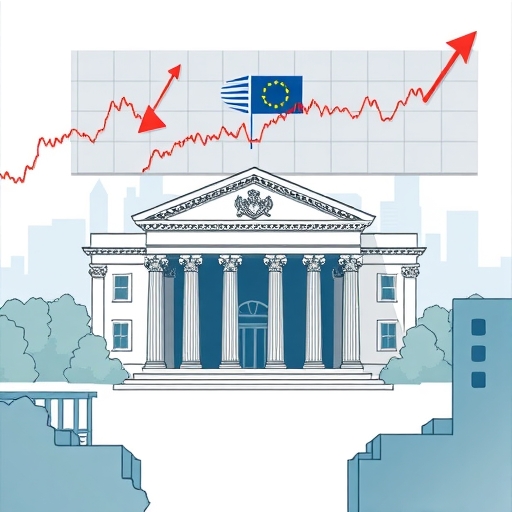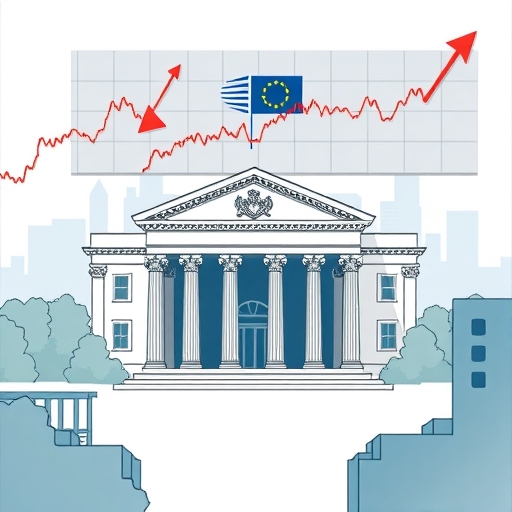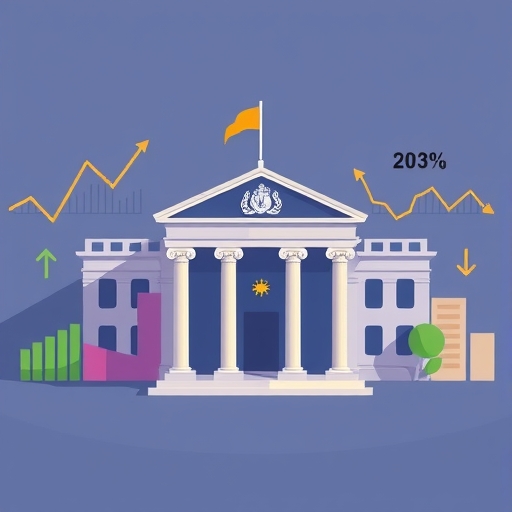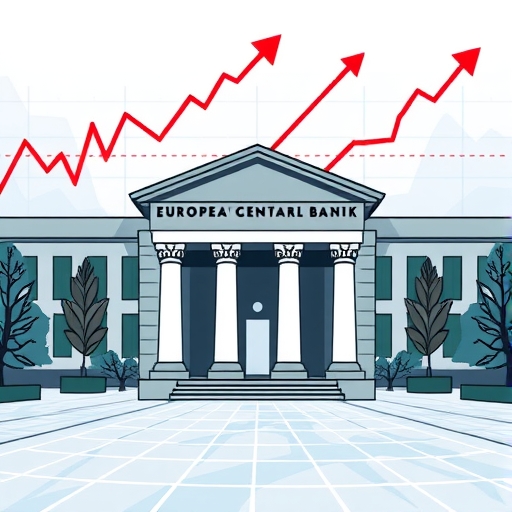
Europe Interest Rates: Why the ECB Paused Decisions and What It Means for You
Table of Contents
ToggleNavigating the Euro Area’s Monetary Crossroads: A Deep Dive into Europe Interest Rates
On July 24, 2025, the European Central Bank (ECB) Governing Council announced a pivotal decision: to keep its three key ECB interest rates unchanged. This move signifies a notable pause after an extended period of monetary easing, shifting the focus from active rate cuts to a strategic period of observation. For you, as an investor or a keen observer of financial markets, understanding this shift in the landscape of Europe interest rates is crucial. Why did the ECB choose to hold steady? What does this mean for the euro area economy, your investment portfolio, and the future trajectory of monetary policy? Let’s embark on a journey to unravel these complexities, turning intricate economic concepts into clear, actionable insights.
- The ECB aims to provide stability in financial markets through its monetary policy decisions.
- Understanding interest rates is essential for making informed investment decisions.
- The current economic landscape requires careful monitoring of both domestic and international factors.
This “wait-and-watch” stance adopted by the ECB reflects a complex interplay of achieved monetary policy goals and newly emerged external uncertainties. We’ll explore these factors in detail, helping you grasp the nuances that guide such critical decisions. Do you often wonder what really goes on behind the closed doors of central bank meetings? It’s a blend of economic data analysis, forward-looking projections, and a keen eye on geopolitical developments, all aimed at fostering price stability and sustainable economic growth.

Decoding the ECB’s July 2025 Decision: A Strategic Hold
The ECB’s decision to maintain the deposit facility rate at 2.00%, the main refinancing operations rate at 2.15%, and the marginal lending facility rate at 2.40% wasn’t a casual one. It marked a significant inflection point, signaling a temporary halt in a series of eight aggressive interest rate cuts that began in June 2024. These past actions successfully brought the key deposit facility rate down from a record high of 4% to its current level. But why the pause now? We understand that for many of you, especially investment beginners, these numbers might seem abstract. Think of these rates as the fundamental cost of money in the euro area – they influence everything from mortgage rates to business loans. When the ECB cuts rates, it generally aims to stimulate economic activity; when it holds, it suggests a period of assessment, often when targets have been met or new uncertainties emerge.
| Rate Type | Current Rate | Previous High |
|---|---|---|
| Deposit Facility Rate | 2.00% | 4.00% |
| Main Refinancing Operations Rate | 2.15% | 4.00% |
| Marginal Lending Facility Rate | 2.40% | 4.00% |
This “wait-and-watch” stance adopted by the ECB reflects a complex interplay of achieved monetary policy goals and newly emerged external uncertainties. We’ll explore these factors in detail, helping you grasp the nuances that guide such critical decisions. Do you often wonder what really goes on behind the closed doors of central bank meetings? It’s a blend of economic data analysis, forward-looking projections, and a keen eye on geopolitical developments, all aimed at fostering price stability and sustainable economic growth.
Inflation’s Victory Lap: Reaching the 2% Target
Perhaps the most compelling reason for the ECB’s pause is the triumphant return of annual inflation in the euro area to its medium-term target of 2%. For years, central banks across the globe grappled with surging prices, a phenomenon amplified by factors like Russia’s invasion of Ukraine and the lingering effects of the COVID-19 pandemic. Now, achieving this 2% target represents a significant milestone in the ECB’s relentless pursuit of price stability. But what does “price stability” truly mean, and why is 2% the magic number?

For us, price stability implies an environment where prices neither rise nor fall too quickly, ensuring that the purchasing power of your money remains relatively consistent over time. It provides a stable foundation for economic planning, investment, and growth. The 2% target is often considered an optimal balance: it’s high enough to avoid the dangers of deflation (a persistent fall in prices, which can cripple economies) but low enough to prevent runaway inflation that erodes savings. The incoming information on the inflation outlook is broadly in line with previous assessments, indicating that this convergence to target is not a fluke but a sustained trend.
Dissecting Domestic Price Pressures and Wage Dynamics
Beyond the headline inflation figure, the ECB carefully scrutinizes underlying components. One of the most encouraging signs for the Governing Council has been the continued easing of domestic price pressures. What are these pressures, and why do they matter? Think of them as the cost of goods and services produced and consumed within the euro area, less the impact of volatile external factors like energy prices or import costs. When these domestic pressures ease, it suggests that inflation is becoming less entrenched within the economy.
| Indicator | Current Trend | Explanation |
|---|---|---|
| Domestic Price Pressures | Easing | Less entrenched inflation signals a healthier economy. |
| Wage Growth | Slowing | Avoiding wage-price spirals aids inflation control. |
| Overall Economic Health | Stable | A strong foundation allows for strategic planning. |
A key indicator contributing to this easing has been slower wage growth. In a healthy economy, wages should ideally rise in line with productivity. However, during periods of high inflation, there’s often a “wage-price spiral” where workers demand higher wages to compensate for rising costs, which in turn leads businesses to raise prices further. The fact that wage growth is moderating suggests that this spiral is being avoided, giving the ECB more confidence that the disinflation process is firmly on track. This internal stability provides a robust foundation, allowing the ECB the flexibility to consider the next set of challenges without immediate inflationary concerns.
Euro Area’s Unexpected Resilience: A Foundation for Policy
Despite a challenging global environment marked by geopolitical tensions and economic headwinds, the euro area economy has demonstrated remarkable overall resilience. This is a testament not only to the inherent strengths of the bloc but also, as the ECB Governing Council acknowledges, partly to the strategic impact of its past interest rate cuts. When rates were aggressively lowered, it provided a much-needed stimulus, making it cheaper for businesses to borrow and invest, and for consumers to spend. This resilience is a critical piece of the puzzle, providing the ECB with the space to pause and assess rather than being forced into immediate action.
- Investment perspectives on euro area resilience are becoming increasingly optimistic.
- Monitoring economic indicators will help gauge future trends.
- Understanding resilience can inform asset allocation strategies.
For you, the investor, this economic resilience translates into a more stable environment for your assets. A strong underlying economy reduces risks and can foster growth in various sectors. But how do we measure this resilience beyond anecdotal observations?
Beyond the Data: PMI, Loan Demand, and Underlying Strength
Central banks rely on a mosaic of economic data to form their assessments. Recent PMI (Purchasing Managers’ Index) survey data, a leading indicator of economic health, has indicated accelerating business activity across the euro area. The PMI surveys thousands of businesses about their output, new orders, employment, and inventories. When it accelerates, it signals expansion and optimism in the private sector.

Furthermore, banks have reported rising loan demand. This is a significant positive signal. When businesses and consumers are confident enough to take on new loans for investment or consumption, it suggests a healthy appetite for growth and a belief in future economic prospects. Coupled with the successful taming of inflation, these indicators collectively bolster the ECB’s current assessment that the euro area economy is in a “good place.” This positive internal outlook is what gives the ECB the strategic advantage to turn its attention to external factors, particularly the brewing storm of international trade relations.
The Geopolitical Undercurrent: US-EU Trade Tensions and the Tariff Specter
While domestic conditions in the euro area appear robust and inflation is under control, the ECB’s decision to pause rate cuts is primarily attributed to an “exceptionally uncertain” global environment. At the heart of this uncertainty are the ongoing US-EU trade disputes and potential tariffs. This isn’t just political rhetoric; it’s a tangible threat that could profoundly impact the economic trajectory of the euro area. The unresolved US-EU trade talks, particularly the looming threat of U.S. tariffs, are casting a significant shadow over the future of global commerce and, by extension, Europe’s economic outlook.
Uncertainty as a Monetary Policy Driver
For central bankers, uncertainty is the enemy of predictability and effective policy. When the future path of trade relations, and therefore economic activity, is clouded, it becomes exceedingly difficult to make long-term monetary commitments. This is why the ECB has adopted a “wait-and-watch” stance, emphasizing a data-dependent, meeting-by-meeting approach. This means they are not pre-committing to any particular future rate path; instead, they will observe how the trade situation evolves, how economic data reacts, and then adjust policy accordingly. It’s like a pilot waiting for clear weather conditions before deciding on the flight path, rather than committing to a route through turbulent skies.
- The current geopolitical landscape is a primary concern for the ECB.
- Market participants must stay informed about changes in trade relations.
- Investors should be prepared to adapt their strategies based on geopolitical developments.
The potential imposition of U.S. tariffs, possibly a 15% baseline on EU goods, is a critical factor that could weigh on eurozone growth and inflation. This looming threat injects a substantial degree of unpredictability into investment decisions and overall economic sentiment. For you as an investor, this translates to heightened market volatility and the need for a nimble strategy. If you’re looking to capitalize on such market movements, understanding the tools available to you is key. If you’re exploring options for currency trading or seeking a platform that offers a wide array of financial instruments, Moneta Markets is a platform worth considering. Hailing from Australia, it provides access to over 1000 financial products, catering to both novice and seasoned traders.
The Tangible Threat of Tariffs: Economic Impact Scenarios
Let’s delve into the specifics of the tariff threat. The possibility of a 15% baseline tariff on EU goods, with some economists even contemplating a worst-case scenario of 30%, presents a direct challenge to the euro area’s economic stability. What would be the immediate and cascading effects?
| Impact | Description |
|---|---|
| Reduced Economic Growth | European exports become more expensive, leading to lower demand. |
| Supply Chain Disruptions | Tariffs disrupt global supply links, forcing costly reconfigurations. |
| Inflationary Pressures | Import prices may rise, but competition could force EU exporters to lower prices. |
| Investment Freeze | Uncertainty leads businesses to delay investments, compounding economic slowdowns. |
The ECB currently views inflation as stabilizing at 2% in the medium term, but the potential imposition of U.S. tariffs could alter this outlook significantly. Their policy will largely depend on whether a trade deal is reached and how the tariffs impact growth and inflation if they are implemented.
Navigating Forward: The ECB’s Data-Dependent Compass
The ECB’s commitment to a data-dependent, meeting-by-meeting approach cannot be overstated. This philosophy dictates that future monetary policy adjustments will not be based on a predetermined schedule or an ideological stance, but rather on the real-time evolution of economic data, inflation trends, and external developments. This flexibility is crucial in an “exceptionally uncertain” world. For you, the investor, this means staying attuned to economic releases and central bank communications is more vital than ever.
- Monitoring economic data closely is crucial for understanding ECB actions.
- The sentiment in markets can shift rapidly based on ECB communications.
- Investors should remain adaptable to address evolving economic realities.
Christine Lagarde has made it clear that there is no pre-commitment to any rate path. This contrasts sharply with periods when central banks might signal their intentions for several meetings ahead to guide market expectations. Now, the message is clear: every meeting is a fresh assessment, and every decision is contingent on the latest information. This pragmatic approach is a hallmark of sophisticated central banking in volatile times.
From Pre-Commitment to Pragmatism: A Flexible Path
In the past, central banks sometimes employed “forward guidance” – providing signals about future policy intentions – to manage market expectations and enhance the effectiveness of their policies. However, in the face of unprecedented uncertainty, rigid forward guidance can become a liability. If circumstances change rapidly, a central bank tied to a pre-commitment might lose credibility or be forced to make a disruptive U-turn. The shift towards a flexible, data-dependent stance reflects a deeper understanding of the fluid nature of today’s global economy. It allows the ECB to be responsive without being reactive, making deliberate choices based on evolving realities.
This means that while the ECB has achieved its inflation target and the euro area economy shows resilience, any significant shift in the trade dispute or unforeseen economic shocks could still prompt further action. What happens if the tariffs are indeed imposed? Or what if a global slowdown occurs? The ECB’s toolkit remains ready, but its deployment will be precisely timed and based on concrete evidence.
Shifting Market Sentiments: Why Expectations Changed
The financial markets, always keen to front-run central bank actions, initially had anticipated further rate cuts, particularly in autumn 2025. However, the ECB’s upbeat assessment of the economy and its firm stance on the 2% inflation target have led to a noticeable shift in market sentiment. Financial markets now see a lower probability for further rate cuts in autumn 2025 compared to previous expectations.
- Understanding market sentiment is key for strategic investment decisions.
- Anticipating changes in monetary policy can affect trading strategies.
- Investors should analyze shifts in expectations as part of their strategy development.
Why this shift? It’s a reflection of market participants absorbing the ECB’s communication and reassessing their own forecasts. When the central bank projects confidence in its inflation target and the economy’s resilience, it raises the bar for additional easing. This upward revision of expectations also influences bond yields, as evidenced by German bond yields rising in response to the ECB’s more confident outlook. For you, this means that the “easy money” period might be drawing to a close, and future investment returns might need to be sought through more targeted strategies, rather than simply riding a wave of declining interest rates. Understanding how market expectations are formed and how they shift is a crucial aspect of developing a robust trading strategy. If you’re ready to refine your approach, selecting a trading platform that offers flexibility and robust technology is paramount. Moneta Markets supports popular platforms like MT4, MT5, and Pro Trader, offering high-speed execution and competitive low spreads for an optimal trading experience.
The ECB’s Comprehensive Toolkit: Beyond Interest Rates
While interest rates are the most visible lever of monetary policy, the ECB possesses a broader array of tools to manage liquidity and ensure financial stability. The central bank has confirmed that its Asset Purchase Programme (APP) and Pandemic Emergency Purchase Programme (PEPP) portfolios are declining, with no reinvestment of maturing securities. What do these programmes entail, and why is their decline significant?
These programmes involved the ECB buying large quantities of bonds from the market, injecting liquidity into the financial system and suppressing long-term interest rates. Their winding down is another signal of monetary policy normalization, reflecting the ECB’s confidence that the economy no longer requires such extraordinary support. It’s akin to a patient being weaned off medication as their health improves.
| Programme | Purpose | Current Status |
|---|---|---|
| Asset Purchase Programme (APP) | Injects liquidity into the economy. | Winding down with no reinvestment. |
| Pandemic Emergency Purchase Programme (PEPP) | Provides additional support during the pandemic. | Declining with no reinvestment. |
| Transmission Protection Instrument (TPI) | Prevents market fragmentation. | Available if needed. |
Furthermore, the Transmission Protection Instrument (TPI) remains available to counter unwarranted market dynamics. The TPI is a relatively new tool, designed to prevent fragmentation in the euro area bond market. In simple terms, it allows the ECB to intervene if borrowing costs for certain euro area countries rise excessively due and disproportionately without economic justification, threatening the smooth transmission of its monetary policy. The continued availability of the TPI assures markets that the ECB has mechanisms in place to safeguard financial stability even in challenging times, providing an additional layer of confidence.
The Euro’s Ascent and Its Deflationary Whisper
The recent strengthening of the euro against the U.S. dollar is another factor being closely monitored by the ECB. While a strong currency can be a sign of economic health and investor confidence, it also carries potential implications for inflation. A stronger euro makes imports cheaper for euro area consumers and businesses. This can have a deflationary impact on import prices, potentially pushing overall inflation lower. Imagine you’re buying a car imported from a country whose currency has weakened against yours; the car effectively becomes cheaper.
The ECB must carefully balance the benefits of a strong currency (e.g., increased purchasing power for citizens travelling abroad, lower import costs) against its potential to drag down inflation, especially if inflation were to undershoot its 2% target. This delicate balance requires constant vigilance and is another reason for the ECB’s current “wait-and-watch” approach. For those involved in forex trading, this dynamic is particularly relevant. The interplay of interest rate differentials and economic sentiment significantly drives currency movements. If you’re seeking a forex broker that offers comprehensive regulatory protection and global trading capabilities, Moneta Markets holds multiple regulatory licenses, including FSCA, ASIC, and FSA. They also offer features like segregated client funds, free VPS, and 24/7 Chinese customer support, making them a preferred choice for many traders.
What Lies Ahead: Awaiting Resolution and Data
The immediate future of Europe interest rates hinges on two primary factors: the resolution of the US-EU trade negotiations and the ongoing flow of economic data. The central bank, market participants, and economic actors will now keenly await definitive news on the tariff front. Will the U.S. and EU reach a deal, or will the tariffs be imposed, potentially triggering a new wave of economic challenges?
- Be prepared for potential market volatility based on trade negotiations.
- Investors must analyze economic data closely to forecast ECB actions.
- Staying informed is essential for making timely investment decisions.
Should a trade deal be reached, alleviating the primary source of uncertainty, the ECB might find more room to maneuver, perhaps even considering further easing if it deems it necessary to support sustained growth without risking inflation. Conversely, if tariffs are imposed, and they significantly weigh on eurozone growth and inflation, the ECB would undoubtedly reassess its pause, potentially prompting further action, such as an additional rate cut in September 2025 or beyond. This demonstrates the reactive nature of central bank policy in the face of external shocks.
Beyond the trade front, the ECB will continue to meticulously analyze every piece of economic data, from inflation figures and wage growth to PMI surveys and loan demand. Each data point provides a clearer picture of the euro area’s economic health and influences the ECB’s forward-looking projections. This continuous assessment ensures that policy remains aligned with the prevailing economic reality, rather than being based on outdated assumptions.
Conclusion: The Grand Balancing Act of Europe Interest Rates
The ECB’s July decision marks a pivotal shift in its monetary policy for Europe interest rates, moving from a period of proactive easing to one of strategic observation. While the successful return of inflation to its 2% target provides a strong foundation and the euro area economy demonstrates commendable resilience, the enduring uncertainty surrounding US-EU trade relations remains the dominant factor shaping the near-term outlook. This is a complex balancing act, where domestic successes are weighed against significant external risks. For you, the informed investor, this scenario underscores the importance of a nuanced understanding of macroeconomic forces, rather than simply reacting to headlines.
We’ve explored how the ECB leverages its comprehensive toolkit, assesses the delicate balance of economic indicators, and navigates the unpredictable currents of global trade. The journey of Europe’s interest rates is far from over; it’s entering a new, more cautious phase. The market, central bank officials, and economic actors will now keenly await resolution on the tariff front and the evolution of economic data, which will collectively determine whether the ECB’s pause evolves into an extended holding pattern or necessitates further adjustments to safeguard price stability and economic growth in the euro area. Stay informed, remain analytical, and continue to learn, for knowledge is your most powerful asset in the dynamic world of investing.
europe interest ratesFAQ
Q:What are the key interest rates set by the ECB?
A:The ECB has established the deposit facility rate at 2.00%, the main refinancing operations rate at 2.15%, and the marginal lending facility rate at 2.40%.
Q:How does inflation affect interest rates?
A:When inflation is high, central banks may raise interest rates to cool down the economy. Conversely, low inflation may prompt cuts to stimulate economic activity.
Q:What factors influence the ECB’s decision-making?
A:The ECB considers domestic economic health, inflation trends, geopolitical developments, and overall market conditions when making monetary policy decisions.
You may also like
Calendar
| 一 | 二 | 三 | 四 | 五 | 六 | 日 |
|---|---|---|---|---|---|---|
| 1 | 2 | 3 | 4 | 5 | 6 | 7 |
| 8 | 9 | 10 | 11 | 12 | 13 | 14 |
| 15 | 16 | 17 | 18 | 19 | 20 | 21 |
| 22 | 23 | 24 | 25 | 26 | 27 | 28 |
| 29 | 30 | 31 | ||||
發佈留言
很抱歉,必須登入網站才能發佈留言。